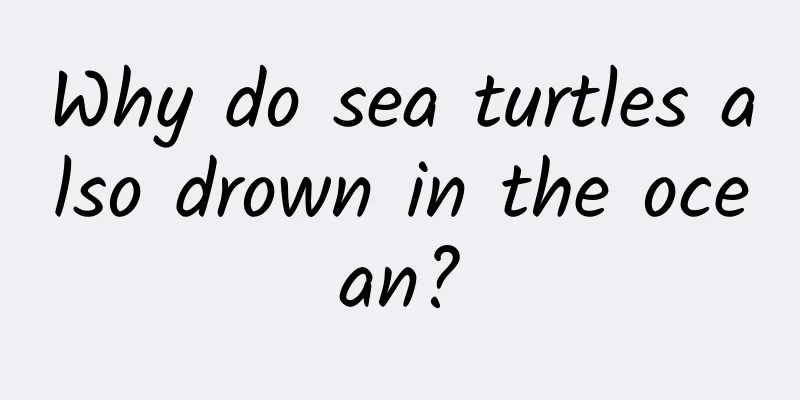Why do sea turtles also drown in the ocean?

|
The Republic of Cape Verde is located in the west of the African continent, 570 kilometers from the West African coastline. Its territory consists of several volcanic islands of varying sizes. Tourism is an important economic pillar of Cape Verde, and the whales, dolphins and sea turtles here attract tourists from all over the world. Beach on Boa Vista Island, Cape Verde | Adriao / wiki commons Thanks to its unique geographical location and climate, five of the seven known species of sea turtles in the world live in Cape Verde. It is also the only important nesting site for loggerhead sea turtles (also known as loggerhead sea turtles and red sea turtles) in the eastern Atlantic . Loggerhead sea turtle (Caretta caretta) on the beach | Dionysisa303 / wiki commons A giant creature that is widespread in the ocean The loggerhead sea turtle is the only species in the genus Cheloniformes of the family Cheloniidae. It is the largest hard-shell turtle in the world and the second largest sea turtle in the world, second only to the leatherback turtle of the family Cheloniidae. Adult loggerhead sea turtles can grow up to 90 cm long and weigh 135 kg. With such a physique, they can even escape from their natural enemies. Sharks are the lifelong enemies of adult loggerhead sea turtles. Some studies have shown that up to 40% of the wounds on female loggerhead sea turtles are caused by shark attacks. As a sea turtle, even if they cannot retract their heads into their shells, their large size and thick scales on their head and neck still provide good protection. Researchers tag a nesting loggerhead sea turtle, showing its enormous size | John and Karen Hollingsworth / wikimedia commons Loggerhead sea turtles are found throughout the Atlantic, Indian, Pacific and Mediterranean oceans, and can be found in waters from temperate to tropical regions. The main food of loggerhead sea turtles is benthic animals in the ocean, and they also eat other animals and algae in the ocean. Jellyfish are also on the diet of loggerhead sea turtles. When they eat smaller jellyfish, they swallow them directly in one mouthful. If they eat larger jellyfish, they eat them like cotton candy, shaking their heads and chewing them piece by piece. The loggerhead sea turtle's powerful mouth can easily crush the shells of crabs, shells and other bottom-dwelling animals. | Brian Gratwicke / wiki commons The Chinese character "蠵" has a long history in ancient books. In the "Shuowen Jiezi·Chongbu" written by Xu Shen of the Eastern Han Dynasty, it says: "蠵, a large turtle." This sentence explains that the original meaning of "蠵" is " a large turtle ." The loggerhead sea turtle has a reddish-brown shell, so it is called a loggerhead sea turtle. This may be different from the "sea turtle" we have in mind - in fact, let alone the loggerhead sea turtle, even the greenest turtle in the family Chelonia mydas does not carry an emerald green shell as often seen in cartoons. Typical coloration of an adult loggerhead sea turtle | Bachrach44 / wiki commons Born to be able to "watch the stars at night" The life span of loggerhead sea turtles is 47-67 years, and they reach sexual maturity at the age of 17-33. From July to October every year, female loggerhead sea turtles build nests in Cape Verde. After crawling onto the beach, they use their hind legs to dig a pit as a place to lay eggs. After laying eggs, they cover the pit with sand to erase any traces of the nest. Loggerhead turtle eggs in a sand pit | Steve Hillebrand / USFWS One night after more than two months, the young turtles will dig through the sand and crawl out of the nest. When on the shore, the young turtles mainly rely on vision to find their way. The bright light of the moon and stars on the sea is a beacon engraved in the genes of the young turtles. They rely on this beacon to crawl to the sea surface. When the young turtles reach the sea, they mainly rely on magnetic sense to find their way. They like to live in the Sargassum clumps. The young turtles need to grow to 45 cm in this "shelter" before they migrate from the open ocean to live in the sea near the land. Sargassum clumps provide shelter for young loggerhead sea turtles | John Martin Davies / Wiki Commons Watching turtles is one of the tourist attractions in Cape Verde. But if you want to watch loggerhead turtles nesting, it is best to sign up for a tour led by a guide certified by the conservation organization . These guides have been working and patrolling the beaches of Cape Verde for many years and know when and where the turtles nest. They plan their visits at night when the turtles are most active, while trying to avoid disturbing or harming the turtles . Loggerhead sea turtle leaves footprints on the beach | Gnaraloo / wiki commons If you turn on the light, they will get lost. In order to obtain the meat and shell of loggerhead turtles, people used to hunt loggerhead turtles. As the legislation of various countries has become more and more perfect, the consumption of loggerhead turtles has decreased a lot, but in some countries or regions where the law enforcement is not strict, people still eat loggerhead turtle eggs and loggerhead turtle meat. Loggerhead sea turtles may also be accidentally caught during offshore fishing, causing accidental death of loggerhead sea turtles; waste plastic dumped into the ocean can easily be ingested by loggerhead sea turtles, causing health problems. When plastic products are contaminated by organisms, they emit a food-like smell, attracting turtles to eat them | europeanscientist.com Human activities also affect the habitat of loggerhead sea turtles. Loggerhead sea turtles need to build nests on sandy beaches that are not flooded by the sea, and human development activities on the coastline will cause loggerhead sea turtles to lose these habitats. Loggerhead sea turtles need wide sandy beaches to lay their eggs. Unfortunately, such beaches are often the preferred locations for bathing beaches and hotels. | Chris 73 / wiki commons Artificial light can also affect nesting sites, disorienting newborns. In Cape Verde, as tourism grows, lights from beaches, passing vehicles and surrounding hotels can disrupt the return journey of baby turtles to the sea. The baby turtles need to follow the light of the moon and stars on the sea to return to the sea, but if there is artificial lighting around, the baby turtles will be misled and go in the wrong direction. If the baby turtles still stay on the beach after dawn, they will either die in the scorching sun or become predators' meals without the cover of night. To avoid this, environmental organizations are also calling on everyone to use turtle-friendly lighting . Try to avoid wavelengths that turtles can see and keep the brightness as low as possible, which can help the little turtles return home smoothly while meeting human lighting needs. Don't let the hatchlings get lost | Denis Luyten / wiki commons Turtles also drown in the sea But the biggest threat to loggerhead sea turtles in the ocean is fishing gear of all kinds . Like whales, dolphins and other marine mammals, loggerhead sea turtles breathe with lungs. Unlike fish, they cannot get oxygen directly from the water, but need to float to the surface from time to time to breathe. If they cannot breathe in time, they will suffocate and die. However, once they are entangled in fishing gear such as trawl nets and gillnets, loggerhead sea turtles have a hard time breaking free by their own efforts and cannot float to the surface to breathe. Moreover, being entangled in fishing gear will cause them to be greatly frightened , and their oxygen consumption will increase sharply. Before people find out, they may have drowned in the sea water long ago. A loggerhead sea turtle drowned in a fishing net | Salvatore Barbera / wiki commons The good news is that environmental groups around the world have been working with fisheries to develop more turtle-friendly fishing gear , such as adding trash and turtle excluder devices (TTEDs) to shrimp trawls. The World Wildlife Fund (WWF) is also trying to promote a new type of hook in the Pacific longline fishery to reduce harm to turtles. As a creature that has existed on Earth 40 million years ago, loggerhead sea turtles have excellent adaptability to life in the ocean. But now, due to human activities, they have to face survival problems they have never encountered in tens of millions of years - getting lost because of lights they have never seen before, and drowning in the most familiar ocean because of unfamiliar equipment. Change the lighting, change the fishing net - the hope of saving sea turtles lies in the hands of mankind. References [1] Ernst CH & Lovich JE (2009). Turtles of the United States and Canada (2nd ed.). JHU Press [2] Spotila JR (2004). Sea Turtles: A Complete Guide to their Biology, Behavior, and Conservation. The Johns Hopkins University Press and Oakwood Arts [3] Duermit L (2006). "ADW: Caretta caretta: INFORMATION". Animaldiversity.org Author: Pei Ran Editor: Old Cat This article comes from the Species Calendar, welcome to forward If you need to reprint, please contact [email protected] |
>>: In the competition of bean nutrition, which "idol" will stand out?
Recommend
Samsung Galaxy S5 first test
Let's start with the appearance. The design of...
It’s Paris again. How come Paris can embrace the Olympic flame three times?
In the hot summer, the 30th Olympic Games is in f...
How to write copy that takes advantage of the Lantern Festival?
The Lantern Festival is coming soon. How to write...
Lu Heping Channel Development and Dealer Management
Teach you to build a channel model that integrate...
The iOS version of WeChat quietly launched the "Tap Tap" function. Netizens: No need to send "Are you there?" anymore
Recently, the iOS version of WeChat was upgraded ...
Lessons from China’s 4G breakthrough
The number of 4G users exceeded 50 million, a goa...
How much does it cost to develop a Zengcheng e-commerce mini program?
Although mini programs have been around for quite...
3 creative strategies to make your product counterattack "short, flat and fast" to capture users
If you are "unfortunate" enough to oper...
How much does it cost to develop a check-in mini program in Zhumadian?
WeChat Mini Program is an application that users ...
Milos training video
Milos training video resources introduction: Cour...
Product Operation | How to combine hot spots to make operation plans?
March 22, 2019, was originally just an ordinary F...
15 messaging platforms worth trying in 2019
【51CTO.com Quick Translation】As we all know, the ...
User operation: How to increase the opening rate of user push?
Activity push is an important way for products to...
Comprehensive analysis of the use of Application
[[435976]] Preface The Application class is somet...









